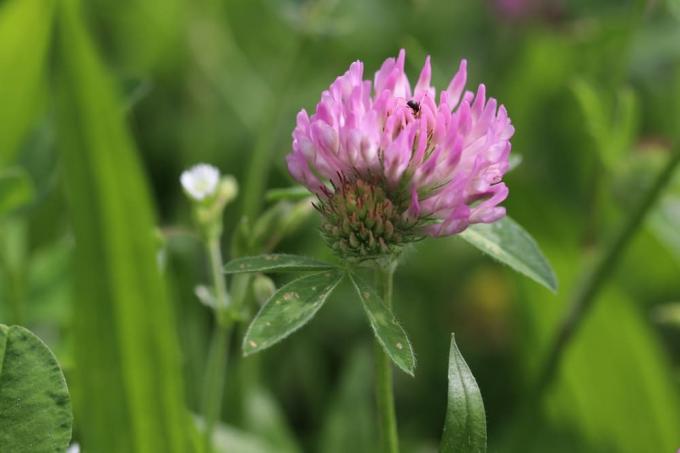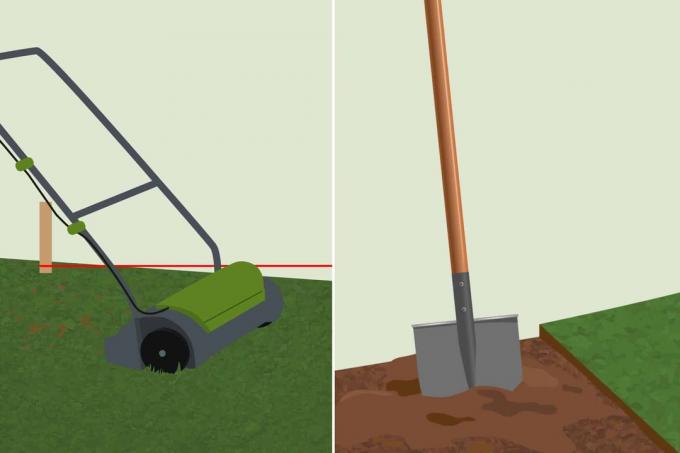

Table of contents
- cause of clover
- The simple journeyman: Remove white clover
- prevent clover growth
- The stubborn companions: Horn and wood sorrel
- A plastic sheet against the clover
- Lawn weed-free - effective, but not environmentally friendly
- Scarifying - an alternative?
- Mow the lawn and avoid nitrogen deficiency
- Fertilize twice a year
While some are looking for the four-leaf clover, hobby gardeners are annoyed about the avoidable lucky charms. Especially when it comes to the lawn, most people don't want it. Luckily, removal is easier than you might think.
cause of clover
Basically, the clover is a good thing because it shows that the lawn is missing something. It mainly occurs when the soil lacks important nutrients. For example, nitrogen can be lacking, which the clover can handle well. The soil should always be moist enough.
The simple journeyman: Remove white clover
The white clover is easy to recognize by its pink flowers. It is relatively easy to banish the lawn by scarifying it. The turf is scratched so that the aeration of the soil can be improved. This should ideally happen between mid-April and mid-May. After that, it should be mowed once or twice a week. This weakens the white clover and the lawn can regain the upper hand.
prevent clover growth
- fertilize regularly (April, June and early to mid-October)
- not too firm and leaning soil
- Water the lawn regularly during dry periods
- Optimum pH value for the lawn: 6
- Buy a pH tester in a hardware store and test it regularly
- The lawn drives out the clover
- Scratch the turf in spring and autumn to get air into the soil
- Don't mow the lawn too often or too deep
The stubborn companions: Horn and wood sorrel
Horn and wood sorrel are a bit more difficult. Horn clover has yellow flowers, wood sorrel reddish-brown. Both of them are not impressed by the mowing, they are even happy about it because they get enough light to be able to grow. Unfortunately, only the ruthless method can help here: The relevant areas must be removed. The roots must be removed in any case, otherwise the clover will come back. The bare spots are then sown again or can be planted with ready-made pieces of lawn. If the majority of the lawn is infested, the only solution is to completely replant the area.
A plastic sheet against the clover
As mentioned above, horn and sorrel clover need light to thrive, so mowing is not suitable. Some hobby gardeners therefore swear by a special method that doesn't look pretty at first, but is said to be very effective. A plastic tarpaulin is to be stretched over the lawn for several weeks. The clover dies because it lacks light. While this also damages the grasses, they are better able to recover from this deprivation. It is best to leave the tarpaulin for 4 weeks. The advantage of this is that with this method, other weeds also disappear in a very environmentally friendly way.
Lawn weed-free - effective, but not environmentally friendly
If you want it easy, you can buy special tools from specialist retailers. So-called pesticides rid the lawn of clover, as this absorbs the agent through the leaves, resulting in very rapid cell growth as soon as it reaches the roots. As a result, the supply of nutrients breaks down and the clover dries out. The first successes can usually be seen after three weeks. Conversely, a chemical agent is not the best alternative if you want to act in an environmentally friendly manner. If you take this remedy, which does not attack monocot grasses, the lawn should not be mowed beforehand. The pesticide needs some "attack surface". In addition, the weather report should be followed, because the days after it should not rain if possible. If there was a longer dry period before the day of application, the lawn should be well moistened beforehand. Bald spots should be pampered afterwards with fertilizer. In order to find the right remedy, you should seek advice from a specialist.
Scarifying - an alternative?
That used to be scarify a popular measure against clover and other weeds. However, this treatment not only killed Klee & Co., but also the Lawn suffered from it. It is much more helpful to grab a rake and use it to remove the clover. This is initially quite time-consuming and labor-intensive, but doing it more often weakens the roots and thus prevents regrowth.
Mow the lawn and avoid nitrogen deficiency
By the way is also common Cut the lawn very effective! But be careful: The cutting length should not be less than 3 - 5 centimeters, otherwise the blades of grass will not have enough leaf mass to regenerate. Her Lawn will thank you!
Too much clover in the garden is often a clear sign of a lack of nitrogen or a signal that the Lawn not feeling well for other reasons. Accordingly, he is simply too weak to defend himself against Klee, dandelion etc. to put up a fight. Which means, that Fertilize would definitely be an interesting possibility. Preferably with one long-term fertilizer.
Fertilize twice a year
So that its active ingredients are released evenly, it is advisable to do it once in April and once in July fertilize. At the moment, the so-called combination products are particularly popular: with these funds It is a product that combines lawn fertilizer and weed killer in equal measure united. This is not only an excellent solution against clover growth, but also helpful for mosses and lichens in the lawn.
If possible, please avoid using too much poison and weed killer, because this ultimately seeps into the groundwater and, in addition, the insects distributed, which are useful for the thriving of the plants in your garden!
 garden editorial
garden editorial I write about everything that interests me in my garden.
Learn more about lawn care

Leveling out unevenness in the lawn: this is how it works
Unevenness in the lawn is annoying and poses a danger to gardeners, playing children and pets. There are a number of methods that can be used to level the lawn. We present them to you in our guide.

Leveling the lawn: how to smooth uneven surfaces
Dents and holes in the lawn are unsightly. We will show you step by step how to smooth uneven areas in the lawn again.

Algae in the garden | Lawn is slippery: what to do?
Algae love rainy days. Can the water seep badly into the ground, even better! The green, slippery mass is not only not a pretty sight, but also a danger for the lawn. Only those who act preventively and correctly in acute cases can avoid permanent damage.

Fighting fungi in the lawn | 10 tips against fungal infestation
Mushrooms in the lawn are not uncommon but annoying and sometimes even dangerous. This is especially true if the garden or green space is also used by pets and children. Here we will show you how to combat fungal infestation.

Aerate the lawn | Before or after mowing?
Sun, water, fertilizer and air are necessary for the lawn to grow. If the lawn does not get enough air, it cannot grow properly. We clarify when the right time to ventilate the lawn is.

Mulching with lawn clippings: 13 things to consider
Keeping the lawn short is a must for many hobby gardeners. However, if the lawn mower does not have a mulching function so that the grass clippings can remain on the lawn, the question arises as to where to put the waste. Because the compost heap is not a good solution here.



